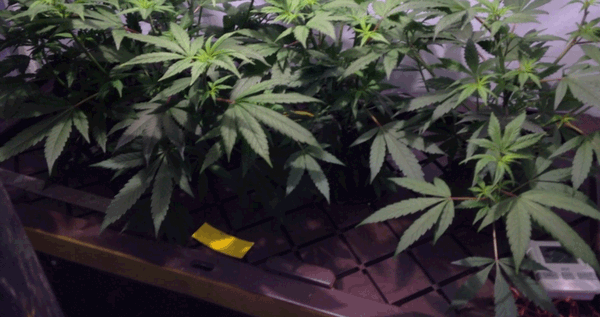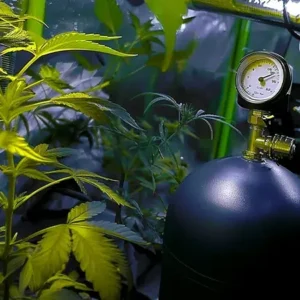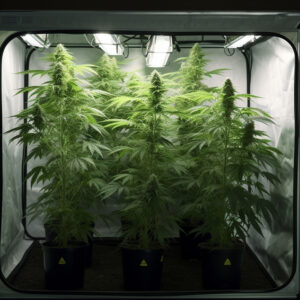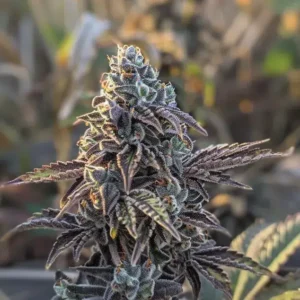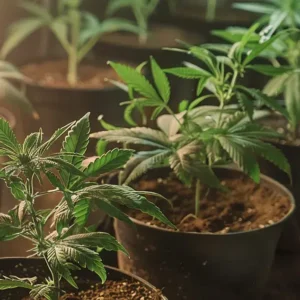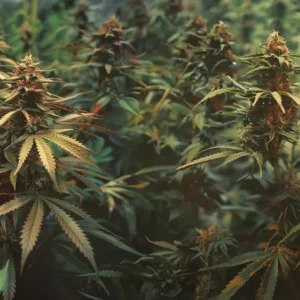Aeroponic growing is a soilless cultivation method that has revolutionized the way plants are grown. By suspending the roots in the air, they are misted with a fine spray of nutrient-rich water, allowing for a more efficient uptake of nutrients and water. This innovative approach curbs the need for a traditional growing medium, thus reducing the risk of soil-borne diseases and pests. Aeroponics is acclaimed for its potential to produce higher yields and healthier plants, as it provides an optimized environment that can be meticulously controlled.
In the realm of cannabis cultivation, this methodology is particularly striking. As cannabis plants have specific requirements for optimum growth, aeroponics offers growers the ability to precisely tailor the conditions to enhance the production of desired compounds such as cannabinoids and terpenes found in the plant’s resinous glands. The stalk of the cannabis plant, which might be overlooked in traditional cultivation methods, can also benefit significantly from the aeroponic system due to increased oxygen exposure and nutrient absorption. However, like any technological advance, aeroponics comes with its own set of challenges that growers must navigate.
Exploring Aeroponic Cultivation
Aeroponics represents a state-of-the-art approach to growing plants without soil, leveraging the advantages of a controlled environment to optimize plant growth. In this method, plants dangle in the air, with their roots kept free, supported by minimal structures. Nutrients essential for their development are supplied through a fine mist directly to the dangling roots. This mist is a water-based solution enriched with minerals and vitamins necessary for healthy plant growth.
Key Components of an Aeroponics System:
- Chamber: A closed or semi-closed area where plants are suspended in air.
- Nutrient Solution: A water-based solution enriched with essential minerals.
- Mist Delivery: An automated misting system disperses nutrients directly to the roots.
- Reservoir Tank: Collects and recycles the unused nutrient solution.
The aeroponic technique contrasts with traditional hydroponics, where plants grow in a water-based nutrient solution, and aquaponics, which combines raising fish and plants mutually. Unlike these techniques, aeroponics does not rely on an inert medium such as clay pellets.
One of the profound applications of aeroponics is in cultivating cannabis. This method promotes faster growth and richer yields due to the increased oxygenation to the roots and the plants’ continuous access to nutrients. Both seeds and clones can thrive under aeroponic conditions, which can be particularly enticing for those looking to grow cannabis efficiently.
This innovation is not entirely new; research into root systems using simple forms of aeroponics dates back to the early 20th century. The 1980s saw an engineering surge in systems for small greenhouses, and even space agencies like NASA have recognized the potential for aeroponics in environments where space is a premium.
Advantages of Aeroponic Cultivation Systems
Aeroponic growing techniques are known for their resource efficiency, often producing higher quality crops while utilizing significantly less water compared to traditional farming or hydroponic setups. Specifically, they can save up to 90% more water than in-ground farming and 40% more than hydroponics. Given the substantial global use of water for irrigation, this reduction in water usage implies a noteworthy conservation of a precious resource.
Key points of aeroponics include:
- Reduced Water Use: By misting roots directly, plants require much less water, contributing to sustainable water management.
- Enhanced Space Utilization: Absence of soil allows tighter plant spacing and innovative farming structures like vertical farming, optimizing the use of space.
- Improved Plant Quality: The direct feeding of nutrients to the roots can result in larger, healthier, and higher-quality plants.
- Operational Control: Growers can meticulously manage and adjust conditions to perfect plant growth and maximize yields.
- Observation and Adaptation: The unobstructed view of root health enables more efficient plant care and nutrient delivery.
- Flexibility in Location: Plants can be grown in various environments without the need for soil, thus expanding potential cultivation areas.
This space-economic method of farming can also be integrated into controlled environments, such as vertical setups, where layers of plants grow one above the other, saving valuable real estate and resources. This strategic use of space can lead to a higher density of plant growth and the feasibility of producing crops in non-traditional agricultural environments.
For the cannabis sector, aeroponics presents an opportunity to significantly enhance product quality. A consistent and controlled nutrient delivery system contributes to robust plant development and cleaner products, which is crucial for a burgeoning industry like the legalized Canadian cannabis market.
Dubbed as a frontrunner in modern agri-food solutions, aeroponic technology can be a critical juncture in meeting the increasing demands for sustainable and high-yield agriculture. As it continues to evolve and gain traction, especially with cannabis Licensed Producers in places like London, Ontario, aeroponics is poised to play a pivotal role in what has been referred to as the “third green revolution” in agriculture.
The Unseen Advantages of Soilless Cultivation
Aeroponic technology presents a shift away from traditional soil-based horticulture, utilizing air or mist to nurture plants. This cultivation method is astonishingly adept at supporting plant life, with a multitude of benefits for both flora and cultivators.
Efficiency Highlights in Aeroponic Systems:
- Significant Water Savings: Uses up to 95% less water than soil farming.
- Targeted Nutrient Delivery: Nutrient-rich mist directly reaches the plant roots, providing what they need, where they need it.
- Enhanced Oxygen Exposure: The suspended roots absorb more oxygen, promoting robust growth.
- Space Optimization: Less space required compared to conventional methods.
- Reduced Resource Waste: Recapturing unused water and nutrients minimizes waste.
In a controlled grow room, the seedlings begin their life cycle without the need for soil. Plants are placed in net pots, and their roots dangle freely to absorb a fine mist rich in nutrients. These mists are delivered through various methods, including high-pressure and low-pressure aeroponics, or the more sophisticated ultrasonic fogger aeroponics.
| Grow Lights | Purpose and Benefit |
|---|---|
| T5s | Provide ample light without excess heat. |
| Cool Grow Lights | Foster growth without risking overheating. |
The misting ensures that roots remain moist but not soaked, creating an environment where water droplets and moisture levels are precisely controlled. Simultaneously, lighting provides the energy needed for photosynthesis, while a regulated supply of CO2 ensures plants have the necessary gas for their growth.
Support systems, such as foam collars and sprinkler heads, keep plants secure while allowing for dispensing of nutrients. In high-pressure aeroponics, a reservoir houses the nutrient solution, which is then propelled towards the roots by specialized sprinkler heads to create a fine mist of water droplets. Meanwhile, **low-pressure setups often employ a cloner, producing a gentler mist for the young plants.
Through this sophisticated yet surprisingly straightforward method, plants can concentrate their energy on upward and outward development rather than expending it on extensive root systems. This leads to not only faster but also more potent plant growth, all without the environmental toll of traditional farming methods.
Challenges of Aeroponic Cultivation
Aeroponic cultivation, while advanced, presents several challenges that can deter those new to this method of gardening. Proper setup and maintenance require significant expertise, as installing the equipment and mixing nutrients demand precision and understanding. Such systems aren’t recommended for beginners due to the intricate balance necessary for success.
The financial commitment for a proper aeroponic setup is substantial, with serious operations often necessitating a hefty investment. The upfront costs predominantly cover high-quality pumps, nozzles, timers, misters, and other specialized equipment that form the backbone of these systems.
- Dependence on electricity: Aeroponic systems rely heavily on continuous power supply.
- Pump and nozzle maintenance: Essential components like pumps and nozzles can fail or become clogged, requiring immediate attention or replacement.
- Environmental control: Maintaining ideal temperature and pH levels is crucial, with any deviation potentially harming the plants.
- Vulnerability to pests and diseases: Issues like root rot, mold, and infestation by pests can be exacerbated if the system isn’t managed correctly.
Despite the allure of aeroponics, prospective growers must consider the risk of power outages, the necessity of closed-loop systems for nutrient delivery, and the potential for equipment malfunctions. A steep learning curve awaits, compounded by the threat that microorganism growth, such as algae, can pose when conditions within the system are less than ideal.
Aeroponic Cultivation’s Impact on Cannabis Quality
Aeroponic systems provide a high degree of control over the cultivation environment, leading to potential increases in cannabis yields and enhancements in the quality of the resulting product. By delivering nutrients and water directly to the exposed roots, these systems can optimize plant growth and potency.
- Trichome Production: Aeroponic growing methods have been linked with stimulated production of trichomes. These tiny, crystal-like structures on the buds are rich in compounds responsible for the plant’s medicinal properties and distinctive flavors.
- Space and Resource Efficiency: Compare to traditional soil-based methods, aeroponics requires less space and uses fewer nutrients and water. This efficiency can result in more robust harvests from a smaller footprint.
- Plant Varieties: Both photoperiod strains and autoflowers can thrive under aeroponic conditions if given the correct care. Cultivators can fine-tune light cycles and nutrient delivery to suit each strain’s specific needs.
- Cloning: Creating cannabis clones is streamlined with aeroponics, as cuttings can directly receive the perfect balance of nutrients and hydration to encourage rapid root development.
While the benefits are significant, aeroponic cultivation requires considerable expertise. Growers must monitor and adjust the nutrient and hydration levels meticulously, with no soil to act as a buffer. Only those with adequate experience in marijuana cultivation should consider this advanced technique to grow high-quality weed. Success in aeroponic cultivation relies heavily on the grower’s expertise and commitment to the care of their marijuana plants.
Common Questions Regarding Aeroponic Cannabis Cultivation
Benefits of Aeroponics for Cannabis Growth
Aeroponics offers several key advantages for growing cannabis. Plants grown in aeroponic systems typically receive more oxygen at the root zone, leading to improved plant health and potentially higher cannabinoid content. Aeroponic cultivation allows for precise control over the plant’s environment, which can result in faster growth rates and can increase the number of harvest cycles per year compared to soil-based methods.
Plant Yield: Aeroponics Versus Hydroponics
When comparing aeroponics to hydroponics, the yields can vary based on several factors such as nutrient delivery, environment control, and plant genetics. Both systems can produce high yields, but aeroponics may edge out hydroponics in terms of oxygenation, which can lead to more robust root systems and possibly greater yields per plant under optimal conditions.
Initiating an Aeroponic Cannabis Cultivation Journal
To begin documenting an aeroponic cannabis grow operation, the following steps should be followed:
- Set up the aeroponic system, ensuring all components are functional.
- Choose the appropriate cannabis strains and procure the necessary clones or seeds.
- Log daily environmental conditions such as temperature, humidity, and pH levels.
- Track nutrient schedules and any adjustments made based on plant responses.
Challenges in Aeroponic Cannabis Cultivation
While aeroponics is an advanced cultivation method, it comes with its challenges. These can include technical difficulties with the system, such as pump failures, which can lead to rapid drying out of the roots. Maintaining the correct nutrient balance and preventing disease in a high-humidity environment are also common issues growers may encounter.
Differences Between Commercial and Small-Scale Aeroponic Cannabis Systems
Commercial aeroponic cannabis operations often involve larger, more complex systems with automation for nutrient delivery and environmental control. In contrast, small-scale setups might be less automated and more hands-on, suitable for personal or hobbyist growers. The scale also affects investment and operational costs, which are substantially higher in commercial ventures.
Designing an Aeroponic Table for Cannabis Growth
When designing an aeroponic table for cannabis, considerations include:
- Size and spacing to accommodate the expected growth of the cannabis plants.
- Materials that are resistant to moisture and won’t degrade in a humid environment.
- The inclusion of a reliable misting system that delivers nutrients effectively.
- Ensuring easy access for maintenance and harvest without disturbing the plant roots.
